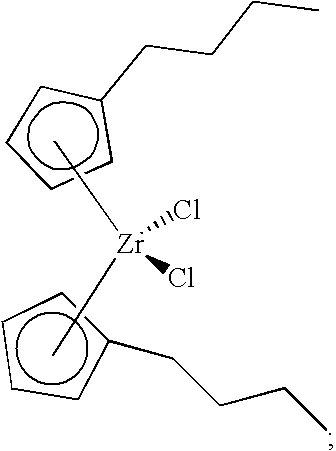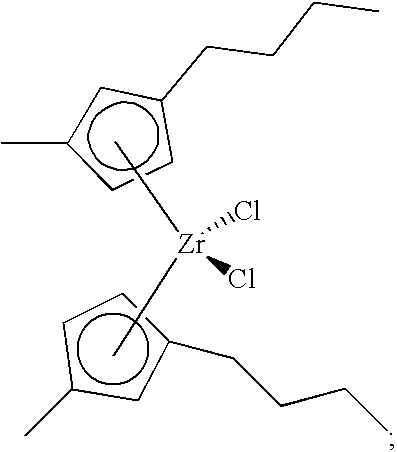Resins that yield low haze films and the process for their production
a technology of resins and olefins, applied in the direction of catalyst activation/preparation, physical/chemical process catalysts, chemical/physical processes, etc., can solve the problems that lldpe films do not exhibit the high clarity and low haze that are required, or at least desired, and achieve low haze and high dart impact
- Summary
- Abstract
- Description
- Claims
- Application Information
AI Technical Summary
Benefits of technology
Problems solved by technology
Method used
Image
Examples
examples
[0159]For each of the following examples, various combinations of the following four metallocenes were evaluated to determine their effect on polymer attributes, particularly dart impact and haze. For convenience, the various metallocenes are set forth below with letter abbreviation:
[0160]
A. Testing Procedure
[0161]Melt index (MI, g / 10 min) was determined in accordance with ASTM D1238 condition F at 190° C. with a 2,160 gram weight.
[0162]High load melt index (HLMI, g / 10 min) was determined in accordance with ASTM D1238 condition E at 190° C. with a 21,600 gram weight.
[0163]Polymer density was determined in grams per cubic centimeter (g / cc) on a compression molded sample, cooled at about 15° C. per hour, and conditioned for about 40 hours at room temperature in accordance with ASTM D1505 and ASTM D1928, procedure C.
[0164]Molecular weights and molecular weight distributions were obtained using a Waters 150 CV gel permeation chromatograph with trichlorobenzene (TCB) as the solvent, with...
examples 1 – 6
D. Examples 1–6
[0188]Various amounts of metallocene C were combined with metallocene A and metallocene B to determine the effect on the resulting polymer haze. Table 2 summarizes the results. As is readily apparent, the presence of metallocene C significantly reduced the haze of the resulting polymer film.
[0189]
TABLE 2Effect of Metallocene C on Polymer Properties.DartMDTDWeightDensityMIImpactTearTearHazeClarityExampleMetalloceneratio(g / cc)(dg / min)(g)(g)(g)(%)(%)1A + B + C3:1:0.240.9171.11>14001794655.398.82A + B + C3:1:0.880.9160.97>14001303828.296.43A + B3:10.9170.9892124635410.098.74A + B3:10.9170.9697322536710.198.25A + B3:10.9160.82>140017633410.397.56A + B3:10.9160.98>140021740213.397.6
examples 7 – 11
E. Examples 7–11
[0190]Various amounts of metallocene D were combined with metallocene A and metallocene B to determine the effect on the resulting polymer haze. Table 3 summarizes the results. In Examples 7 and 8, the haze of the polymer film was significantly reduced.
[0191]
TABLE 3Effect of Metallocene D on Polymer Properties.DartMDTDWeightDensityMIImpactTearTearHazeClarityExampleMetalloceneratio(g / cc)(dg / min)(g)(g)(g)(%)(%)7A + B + D1.9:1:0.450.9181.065361725578.398.58A + B + D1.9:1:0.470.9171.16>14001964889.497.89A + B + D1.9:1:0.840.9171.32132314252611.998.710A + B1.9:10.9181.21>140021438910.297.611A + B1.9:10.9191.3169427546917.094.4
[0192]In sum, the present invention provides a catalyst composition and a method for producing a polymer that can be used to produce film having low haze. The catalyst composition includes a first metallocene compound, a second metallocene compound, a third metallocene compound, a chemically-treated solid oxide, and an organoaluminum compound. At lea...
PUM
| Property | Measurement | Unit |
|---|---|---|
| haze | aaaaa | aaaaa |
| haze | aaaaa | aaaaa |
| temperature | aaaaa | aaaaa |
Abstract
Description
Claims
Application Information
 Login to View More
Login to View More - R&D
- Intellectual Property
- Life Sciences
- Materials
- Tech Scout
- Unparalleled Data Quality
- Higher Quality Content
- 60% Fewer Hallucinations
Browse by: Latest US Patents, China's latest patents, Technical Efficacy Thesaurus, Application Domain, Technology Topic, Popular Technical Reports.
© 2025 PatSnap. All rights reserved.Legal|Privacy policy|Modern Slavery Act Transparency Statement|Sitemap|About US| Contact US: help@patsnap.com



